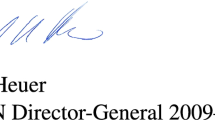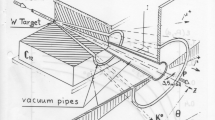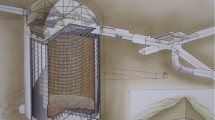Abstract—
The physics of neutrino oscillations is a rapidly developing area of study of the fundamental properties of these particles. In this article, we present the status of an experimental study of three-flavor oscillations after the largest conference in neutrino physics (Neutrino 2020). Prospects and unresolved problems are discussed.













Similar content being viewed by others
Notes
The preprint was published in arxiv in September 2010, the article was published in March 2011.
Fit values including Super-Kamiokande data are given.
Thus, their use for testing unitarity is not entirely correct. Nevertheless, the authors of [85] argue that in the absence of unitarity in the experimental data, fitting them in the unitarity approximation will generate a certain structure from different types of experiments on complex planes, which can be considered as an indication of nonunitarity.
REFERENCES
C. Cowan, F. Reines, F. Harrison, H. Kruse, and A. McGuire, “Detection of the free neutrino: A confirmation,” Science, 124, 103–104 (1956).
Raymond Davis, Jr., D. S. Harmer, and K. C. Hoffman, “Search for neutrinos from the sun,” Phys. Rev. Lett. 20, 1205–1209 (1968).
J. N. Bahcall, N. Cabibbo, and A. Yahil, “Are neutrinos stable particles?,” Phys. Rev. Lett. 28, 316–318 (1972).
A. Cisneros, “Effect of neutrino magnetic moment on solar neutrino observations,” Astrophys. Space Sci. 10, 87–92 (1971).
E. E. Salpeter, “Difficulties with fusion catalysis by quarks,” Nature, 225, 165–166 (1970).
Y. Fukuda et al. (Super-Kamiokande Collab.), “Evidence for oscillation of atmospheric neutrinos,” Phys. Rev. Lett. 81, 1562–1567 (1998); arXiv:9807003[hep-ex].
Q. Ahmad et al. (SNO Collab.), “Direct evidence for neutrino flavor transformation from neutral current interactions in the Sudbury Neutrino Observatory,” Phys. Rev. Lett. 89, 011301 (2002); arXiv: 0204008[nucl-ex].
The Nobel Prize in Physics 2015. https://www.nobelprize.org/prizes/physics/2015/ summary/.
B. Pontecorvo, “Inverse beta processes and nonconservation of lepton charge,” Sov. Phys. JETP 7, 172 (1957).
S. Bilenky and B. Pontecorvo, “Lepton mixing and neutrino oscillations,” Phys. Rep., 41, 225–261 (1978).
Z. Maki, M. Nakagawa, and S. Sakata, “Remarks on the unified model of elementary particles,” Prog. Theor. Phys. 28, 870–880 (1962).
S. Bilenky, Introduction to the Physics of Massive and Mixed Neutrinos, (Springer, 2018), Vol. 947.
L. Wolfenstein, “Neutrino oscillations in matter,” Phys. Rev. D 17, 2369–2374 (1978).
S. Mikheyev and A. Smirnov, “Resonance amplification of oscillations in matter and spectroscopy of solar neutrinos,” Sov. J. Nucl. Phys. 42, 913–917 (1985).
M. Rayner, Tuning in to neutrinos: July/August 2020; https://cds.cern.ch/record/2722711/files/CERNCourier2020JulAugdigitaledition.
S. Pascoli, S. Petcov, and A. Riotto, “Connecting low energy leptonic CP violation to leptogenesis,” Phys. Rev. D 75, 083511 (2007); arXiv: 0609125[hep-ph].
G. Branco, R. Felipe Gonzalez, and F. Joaquim, “A new bridge between leptonic CP violation and leptogenesis,” Phys. Lett. B 645, 432–436 (2007); arXiv: 0609297[hep-ph].
S. Davidson, J. Garayoa, F. Palorini, and N. Rius, “Insensitivity of flavoured leptogenesis to low energy CP violation,” Phys. Rev. Lett. 99, 161801 (2007); arXiv: 0705.1503[hep-ph].
. C. Branco, T. Morozumi, B. Nobre, and M. Rebelo, “A bridge between CP violation at low-energies and leptogenesis,” Nucl. Phys. B 617, 475–492 (2001); arXiv: 0107164[hep-ph]
S. Bőser, C. Buck, C. Giunti, J. Lesgourgues, L. Ludhova, S. Mertens, A. Schukraft, and M. Wurm, “Status of light sterile neutrino searches,” Prog. Part. Nucl. Phys. 111, 103736 (2020); arXiv:1906.01739.
M. J. Dolinski, A. W. Poon, and W. Rodejohann, “Neutrinoless double-beta decay: Status and prospects, Ann. Rev. Nucl. Part. Sci. 69, 219–251 (2019); arXiv:1902.04097.
M. Aker et al. (KATRIN Collab.), “Improved upper limit on the neutrino mass from a direct kinematic method by KATRIN,” Phys. Rev. Lett. 123, 221802 (2019); arXiv:1909.06048.
G. Drexlin, V. Hannen, S. Mertens, and C. Weinheimer, “Current direct neutrino mass experiments,” Adv. High Energy Phys. 2013, 293986 (2013); arXiv: 1307.0101 [physics.ins-det].
G. de Wasseige et al. (IceCube, KM3NeT Collab.), “High-energy neutrino astronomy: Current status and prospects,” 2019 European Physical Society Conference on High Energy Physics (2019); arXiv:1911.01719.
Neutrino 2020 website. https://conferences.fnal. gov/nu2020/.
I. Esteban, M. Gonzalez-Garcia, M. Maltoni, T. Schwetz, and A. Zhou, The fate of hints: Updated global analysis of three-flavor neutrino oscillations (2020); arXiv:2007.14792.
P. de Salas, D. Forero, S. Gariazzo, P. Martínez-Miravé, O. Mena, C. Ternes, M. Tórtola, and J. Valle, Global reassessment of the neutrino oscillation picture (2020); arXiv:2006.11237.
P. Zyla et al. (Particle Data Group Collab.), Rev. Part. Phys. PTEP 2020, 083C01 (2002).
Q. Ahmad et al. (SNO Collab.), “Measurement of day and night neutrino energy spectra at SNO and constraints on neutrino mixing parameters,” Phys. Rev. Lett. 89, 011302 (2002); arXiv:0204009[nucl-ex].
K. Eguchi et al. (KamLAND Collab.), “First results from KamLAND: Evidence for reactor anti-neutrino disappearance,” Phys. Rev. Lett. 90, 021802 (2003); arXiv:0212021[hep-ex].
S. Fukuda et al. (Super-Kamiokande Collab.), “Determination of solar neutrino oscillation parameters using 1496 days of Super-Kamiokande I data,” Phys. Lett. B 539, 179–187 (2002); arXiv:0205075[hep-ex].
J. N. Bahcall, “Solar models and solar neutrinos: Current status,” Phys. Scripta 121, 46–50 (2005); arXiv: 0412068[hep-ph].
B. Aharmim et al. (SNO Collab.), “Combined analysis of all three phases of solar neutrino data from the Sudbury Neutrino Observatory,” Phys. Rev. C 88, 025501 (2013); arXiv:1109.0763[nucl-ex].
N. Jelley, A. B. McDonald, and R. Robertson, “The Sudbury Neutrino Observatory,” Ann. Rev. Nucl. Part. Sci. 59, 431–465 (2009).
S. Petcov and M. Piai, “The LMA MSW solution of the solar neutrino problem, inverted neutrino mass hierarchy and reactor neutrino experiments,” Phys. Lett. B 533, 94–106 (2002); arXiv:0112074[hep-ph].
S. Andringa et al. (SNO+ Collab.), “Current status and future prospects of the SNO+ experiment, “Adv. High Energy Phys. 2016, 6194250 (2016); arXiv: 1508.05759.
A. Gando et al. (KamLAND Collab.), “Reactor on-off antineutrino measurement with KamLAND,” Phys. Rev. D 88, 033001 (2013); arXiv:1303.4667[hep-ex].
A. Suzuki, “Antineutrino science in KamLAND,” Eur. Phys. J. C 74, 3094 (2014); arXiv:1409.4515[hep-ex].
T. Araki et al., “Experimental investigation of geologically produced antineutrinos with KamLAND,” Nature, 436, 499–503 (2005).
A. Gando et al. (KamLAND Collab.), “Constraints on θ13 from a three-flavor oscillation analysis of reactor antineutrinos at KamLAND,” Phys. Rev. D 83, 052002 (2011); arXiv:1009.4771[hep-ex].
T. Haines et al., “Calculation of atmospheric neutrino induced backgrounds in a nucleon decay search,” Phys. Rev. Lett. 57, 1986–1989 (1986).
M. Nakahata et al. (Kamiokande Collab.), “Atmospheric neutrino background and pion nuclear effect for Kamioka nucleon decay experiment,” J. Phys. Soc. Jap. 55, 3786 (1986).
K. S. Hirata et al. (Kamiokande-II Collab.), “Experimental study of the atmospheric neutrino flux,” Phys. Lett. B 205, 416–420 (1988).
A. Renshaw et al. (Super-Kamiokande Collab.), “First indication of terrestrial matter effects on solar neutrino oscillation,” Phys. Rev. Lett. 112, 091805 (2014); arXiv:1312.5176[hep-ex].
Y. Nakajima, Recent results and future prospects from Super-Kamiokande (2020); https://indico.fnal.gov/ event/43209/contributions/187863/attachments/129474/ 159089/nakajima_Neutrino2020.pdf.
Introduction of Gadolinium into Super-Kamiokande and the Start of New Observations. http://www-sk.icrr.utokyo.ac.jp/sk/news/2020/08/sk-gd-detail-e.html.
J. F. Beacom and M. R. Vagins, “Anti-neutrino spectroscopy with large water Cherenkov detectors,” Phys. Rev. Lett. 93, 171101 (2004); arXiv: 0309300[hep-ph].
T. Schwetz-Mangold et al. (NuFIT Collab.), Personal communication. 2020.
F. P. An et al. (Daya Bay Collab.), “Improved measurement of the reactor antineutrino flux and spectrum at Daya Bay,” Chin. Phys. C 41, 013002 (2017); arXiv:1607.05378.
F. An et al. (JUNO Collab.), “Neutrino physics with JUNO,” J. Phys. G 43, 030401 (2016); arXiv: 1507.05613.
M. Apollonio et al. (CHOOZ Collab.), “Limits on neutrino oscillations from the CHOOZ experiment,” Phys. Lett. B 466, 415–430 (1999); arXiv: 9907037[hep-ex].
F. Boehm et al. “Search for neutrino oscillations at the Palo Verde nuclear reactors,” Phys. Rev. Lett. 84, 3764–3767 (2000); arXiv:9912050[hep-ex].
M. Apollonio et al. (CHOOZ Collab.), “Search for neutrino oscillations on a long baseline at the CHOOZ nuclear power station,” Eur. Phys. J. C 27, 331–374 (2003); arXiv:0301017[hep-ex].
F. Boehm et al., “Final results from the Palo Verde neutrino oscillation experiment,” Phys. Rev. D 64, 112001 (2001); arXiv: 0107009[hep-ex].
X. Guo et al. (Daya Bay Collab.), A precision measurement of the neutrino mixing angle θ 13 using reactor antineutrinos at Daya-Bay (2007); arXiv: 0701029[hep-ex].
F. Ardellier et al. (Double Chooz Collab.), Double Chooz: A search for the neutrino mixing angle θ13 (2006); arXiv: 0606025[hep-ex].
J. Ahn et al. (RENO Collab.), RENO: An experiment for neutrino oscillation parameter θ 13 using reactor neutrinos at Yonggwang (2010); arXiv:1003.1391[hep-ex].
L. Mikaelyan and V. Sinev, “Neutrino oscillations at reactors: What is next?,” Phys. At. Nucl., 63, 1002 (2000); arXiv: 9908047[hep-ex].
E. Ables et al. (MINOS Collab.), P-875: A Long baseline neutrino oscillation experiment at Fermilab (1995).
K. Abe et al. (T2K Collab.), “The T2K experiment,” Nucl. Instrum. Methods Phys. Res. A 659, 106–135 (2011); arXiv:1106.1238 [physics.ins-det].
K. Abe et al. (T2K Collab.), T2K ND280 upgrade: Technical design report (2019); arXiv:1901.03750.
K. Abe et al. (T2K Collab.), “Indication of electron neutrino appearance from an accelerator-produced off-axis muon neutrino beam,” Phys. Rev. Lett. 107, 041801 (2011); arXiv:1106.2822[hep-ex].
P. Adamson et al. (MINOS Collab.), “Improved search for muon-neutrino to electron-neutrino oscillations in MINOS,” Phys. Rev. Lett. 107, 181802 (2011); arXiv:1108.0015[hep-ex].
Y. Abe et al. (Double Chooz Collab.), “Indication of reactor νe disappearance in the Double Chooz Experiment,” Phys. Rev. Lett. 108, 131801 (2012); arXiv: 1112.6353[hep-ex].
F. P. An et al. (Daya Bay Collab.), “Observation of electron antineutrino disappearance at Daya Bay,” Phys. Rev. Lett. 108, 171803 (2012); arXiv:1203.1669 [hep-ex].
J. Ahn et al. (RENO Collab.), “Observation of reactor electron antineutrino disappearance in the RENO experiment,” Phys. Rev. Lett. 108, 191802 (2012); arXiv: 1204.0626[hep-ex].
D. Adey et al. (Daya Bay Collab.), “Measurement of the electron antineutrino oscillation with 1958 days of operation at Daya Bay,” Phys. Rev. Lett. 121, 241805 (2018); arXiv:1809.02261.
J. Yoo, Recent results from RENO experiment (2020); https://indico.fnal.gov/event/43209/contributions/ 187886/attachments/130339/158753/Neutrino2020Yoo RENO.pdf.
F. An et al. (Daya Bay Collab.), “New measurement of θ13 via neutron capture on hydrogen at Daya Bay,” Phys. Rev. D 93, 072011 (2016); arXiv:1603.03549.
T. Bezerra, New results from the Double Chooz experiment (2020); https://indico.fnal.gov/event/43209/contributions/ 187822/attachments/129095/158797/DoubleChooz_Neutrino2020_thiago_vFinal.pdf.
P. Dunne, Latest neutrino oscillation results from T2K (2020); https://indico.fnal.gov/event/43209/contributions/187830/attachments/129636/159603/T2K_Neutrino2020.pdf.
M. H. Ahn et al. (K2K Collab.), “Measurement of neutrino oscillation by the K2K experiment,” Phys. Rev. D 74, 072003 (2006); arXiv:0606032[hep-ex].
D. Michael et al. (MINOS Collab.), “Observation of muon neutrino disappearance with the MINOS detectors and the NuMI neutrino beam,” Phys. Rev. Lett. 97, 191801 (2006); arXiv: 0607088[hep-ex].
K. Abe et al. (T2K Collab.), “Measurement of neutrino oscillation parameters from muon neutrino disappearance with an off-axis beam,” Phys. Rev. Lett. 111, 211803 (2013); arXiv:1308.0465[hep-ex].
I. Yu, New Results from RENO (2018). https://zenodo.org/record/1287949.X0zdMC1eN8Y.
P. Adamson et al. (MINOS+ Collab.), Precision constraints for three-flavor neutrino oscillations from the full MINOS+ and MINOS data set (2020), 6; arXiv: 2006.15208.
M. Aartsen et al. (IceCube Collab.), “Measurement of atmospheric neutrino oscillations at 6–56 GeV with IceCube DeepCore,” Phys. Rev. Lett. 120, 071801 (2018); arXiv:1707.07081.
A. Himmel, New oscillation results from the NOvA experiment (2020); https://indico.fnal.gov/event/43209/contributions/187840/attachments/130740/159597/NOvA-Oscilations-NEUTRINO2020.pdf.
M. Aartsen et al. (IceCube Collab.), “Measurement of atmospheric neutrino oscillations with IceCube,” Phys. Rev. Lett. 111, 081801 (2013); arXiv: 1305.3909[hep-ex].
R. Abbasi et al. (IceCube Collab.), “The design and performance of IceCube DeepCore,” Astropart. Phys. 35, 615–624 (2012); arXiv:1109.6096[astro-ph.IM].
D. Ayres et al. (NOvA Collab.), NOvA: Proposal to build a 30 kiloton off-axis detector to study ν µ → ν e oscillations in the NuMI beamline (2004), 3; arXiv: 0503053[hep-ex].
K. Abe et al. (T2K Collab.), “Constraint on the matter–antimatter symmetry-violating phase in neutrino oscillations,” Nature, 580, No. 7803, 339–344 (2020); [Erratum]: Nature 583, E 16 (2020)]; arXiv: 1910.03887.
NOvA and T2K joint analysis announcement. https://t2k-experiment. org/2018/01/t2k-nova-announce/.
Y. Farzan and A. Smirnov, “Leptonic unitarity triangle and CP violation,” Phys. Rev. D 65, 113001 (2002); arXiv:0201105[hep-ph].
S.A.R. Ellis, K. J. Kelly, and S.W. Li, Leptonic Unitarity Triangles (2020). 4. arXiv:2004.13719.
B. Abi et al. (DUNE Collab.), Deep Underground Neutrino Experiment (DUNE): Far detector technical design report, Vol. II DUNE Physics (2020), 2; arXiv: 2002.03005.
K. Abe et al. (Hyper-Kamiokande Collab.), Hyper-Kamiokande Design Report (2018), 5; arXiv: 1805.04163.
K. Abe et al. (Hyper-Kamiokande Collaboration), “Physics potentials with the second Hyper-Kamiokande detector in Korea,” PTEP, 2018, 063C01 (2018); arXiv:1611.06118.
M. Jiang, “Study of the neutrino mass hierarchy with the atmospheric neutrino data collected in Super-Kamiokande IV”, PhD Thesis. http://www-sk.icrr.u-tokyo.ac.jp/sk/pdf=articles=2019=mjiangdt:pdf.
M. Aartsen et al. (IceCube-Gen2, JUNO Collab), “Combined sensitivity to the neutrino mass ordering with JUNO, the IceCube Upgrade, and PINGU,” Phys. Rev. D 101, 032006 (2020); arXiv:1911.06745.
S. Ahmed et al. [ICAL Collab.], “Physics potential of the ICAL detector at the India-based Neutrino Observatory (INO),” Pramana, 88, No. 5, 79 (2017); arXiv: 1505.07380.
A. Ishihara et al. (IceCube Collab.), The IceCube upgrade-design and science goals, PoSI (2020). V. CRC2019. P. 1031; arXiv:1908.09441.
J. van Santen (IceCube Gen2 Collab.), IceCube-Gen2: The next-generation neutrino observatory for the South Pole, PoSI. 2018. V. CRC2017. P. 991.
M. Aartsen et al. (IceCube Collab.), “PINGU: A vision for neutrino and particle physics at the south pole,” J. Phys. G 44, 054006 (2017); arXiv:1607.02671.
S. Adrian-Martinez et al. (KM3Net Collab.), “Letter of intent for KM3NeT 2.0,” J. Phys. G 43, 084001 (2016); arXiv:1601.07459.
A. D. Avrorin et al. (Baikal-GVD Collab.], “Baikal-GVD: Status and prospects,” EPJ Web Conf. 2018. V. 191. P. 01006; arXiv:1808.10353.
E. Wildner et al., “The opportunity offered by the ESSnuSB project to exploit the larger leptonic CP violation signal at the second oscillation maximum and the requirements of this project on the ESS accelerator complex,” Adv. High Energy Phys., 2016, 8640493 (2016); arXiv:1510.00493.
H. Nunokawa, S. J. Parke, and J. W. Valle, “CP violation and neutrino oscillations,” Prog. Part. Nucl. Phys. 60, 338–402 (2008); arXiv:0710.0554 [hep-ph].
E. Bouquerel, E. Baussan, M. Dracos, T. Ekelőf, and A. Topaksu Kayis, “The ESSνSB Project,” Proceedings of the 21st International Workshop on Neutrinos from Accelerators, Aug 2019, Daegu, South Korea, P. 024 (2019).
M. Blennow, E. Fernandez-Martinez, T. Ota, and S. Rosauro-Alcaraz, “Physics potential of the ESSνSB,” Eur. Phys. J. C 80, 190 (2020); arXiv:1912.04309.
ACKNOWLEDGMENTS
The team of authors thanks M.O. Gonchar for useful discussions and advices.
Funding
The work was supported by the Russian Science Foundation (project no. 18-12-00271) and Russian Foundation for Basic Research (project no. 19-32-90058).
Author information
Authors and Affiliations
Corresponding authors
Additional information
Translated by G. Dedkov
Rights and permissions
About this article
Cite this article
Kolupaeva, L.D., Olshevskiy, A.G. & Samoylov, O.B. Status and Research Prospects of Three-Flavor Neutrino Oscillations. Phys. Part. Nuclei 52, 357–373 (2021). https://doi.org/10.1134/S1063779621030060
Received:
Revised:
Accepted:
Published:
Issue Date:
DOI: https://doi.org/10.1134/S1063779621030060




